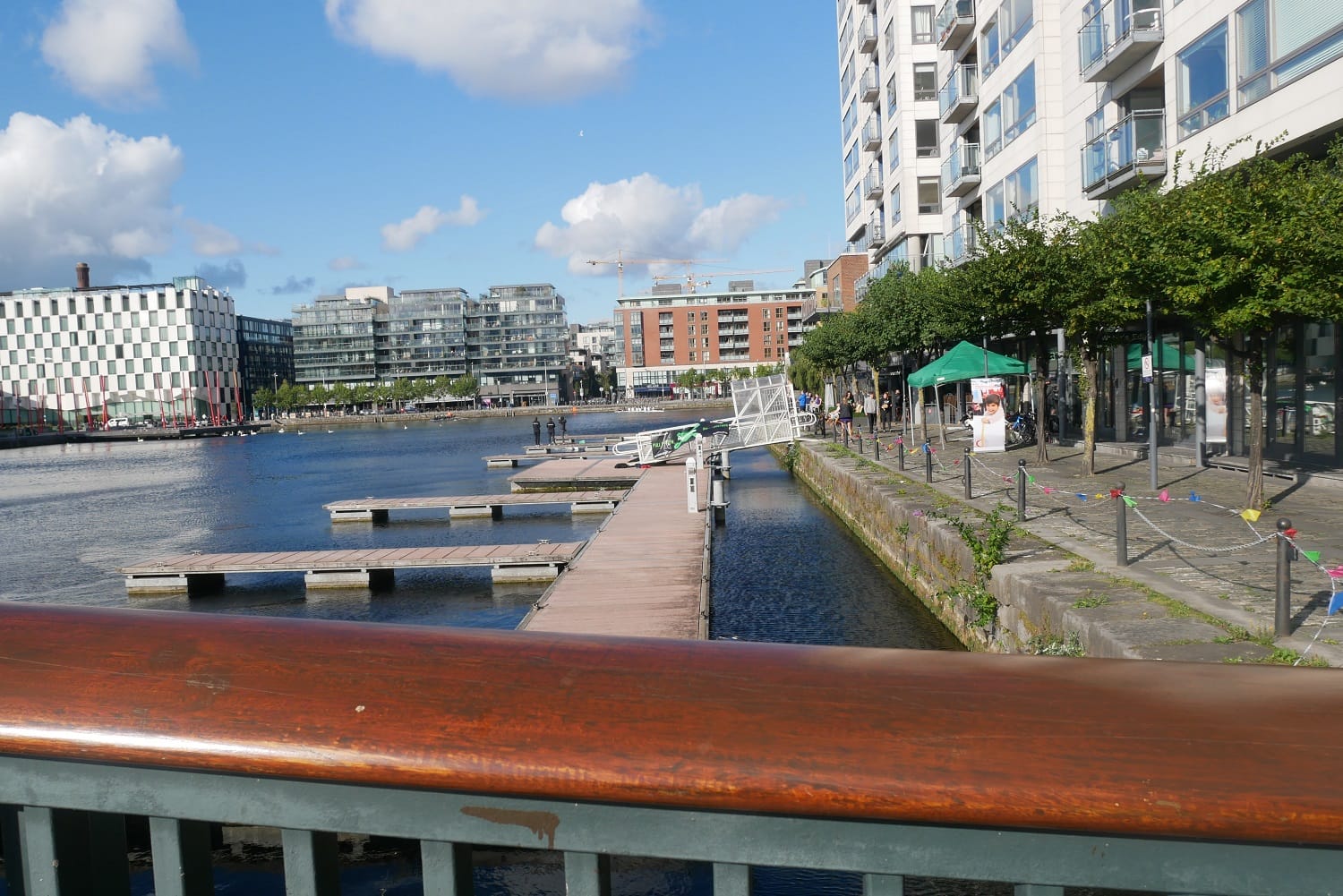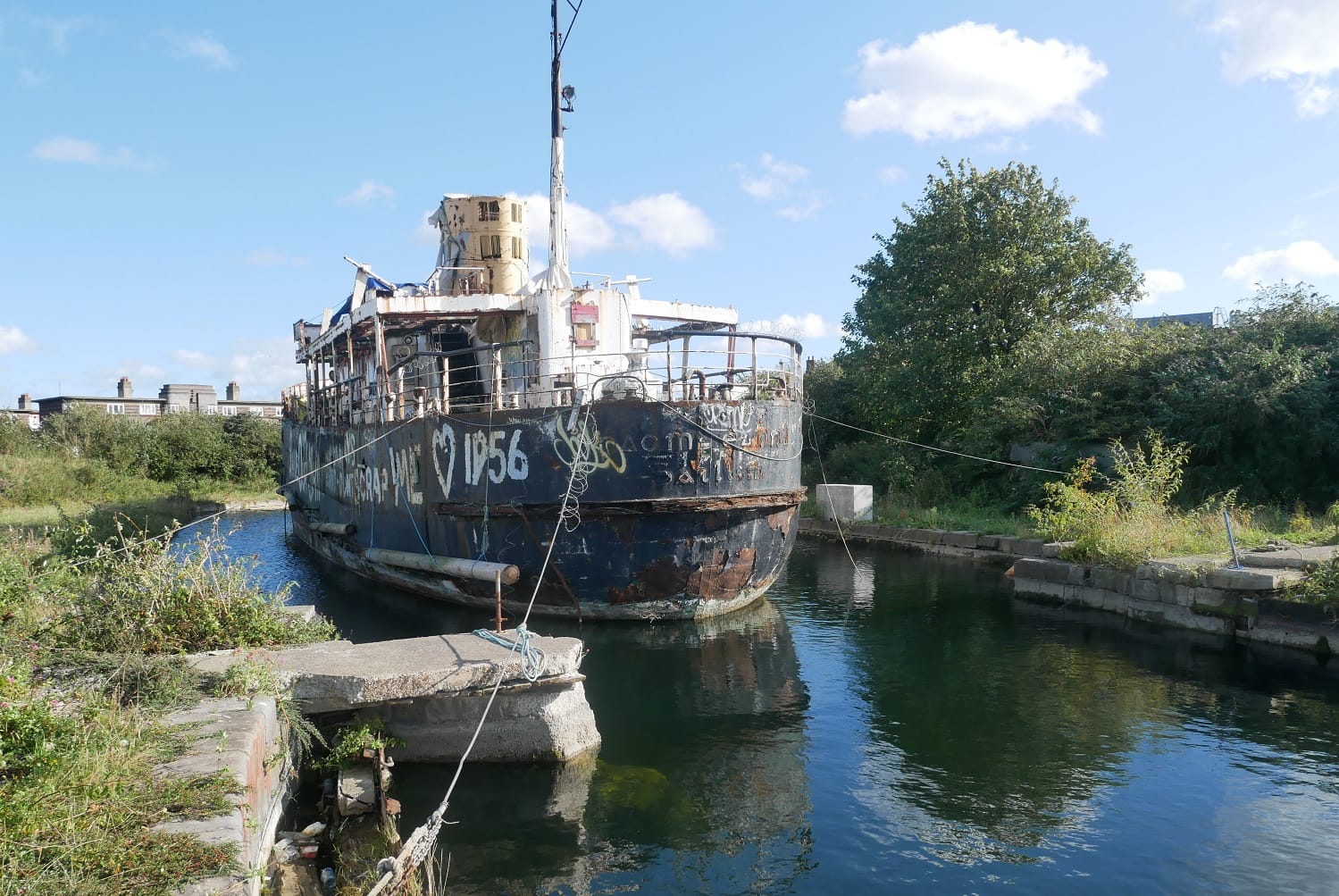What’s the best way to tell area residents about plans for a new asylum shelter nearby?
The government should tell communities directly about plans for new asylum shelters, some activists and politicians say.
Any vision for this corner of the Docklands should respect the history of the 18th-century dry docks, says Reg McCabe of the Inland Waterways Association of Ireland.

Reg McCabe walks through a gate that separates the lot of the Dublin Viking Splash Tours from an overgrown, patchy area of land on the Grand Canal Basin.
He trails around to Dublin’s last two remaining graving docks, narrow basins that can be flooded to allow a ship to float, or drained to set it upon land.
Opened in 1796, they were used for ship and boat building and repairs until the 1960s, says McCabe, who handles public relations for the Inland Waterways Association of Ireland (IWAI).
He points to metal tracks on the ground. “That goes back to the period where there was boat-building activity here,” he says.
This would have been used to move the boats, he explains. They were hauled up onto the site using a pulley system. “That would have been mainly in the 19th century.”
McCabe and others would like to see these graving docks used again, their nautical past brought back to life. “Boatbuilding, maybe boat repairing,” he says.
Where the Viking Splash Tours lot is now was once another graving dock, but it’s been filled in. “It wasn’t being used,” McCabe says.
It’s fortunate, he says, that the other two dry docks haven’t met a similar fate.
Down from the gate and to the left is the largest of the three graving docks, where a large, derelict ship called the Naom Éanna sits on the water.
McCabe walks up to the top of one, where a steel barrier separates it from the rest of the Grand Canal’s water.

“What was originally here was lock gates, which you could open and close,” he says. “But they were taken away and this dam was put it. The problem is, it doesn’t work anymore.”
Same for the system that drained the dock of water and poured it into the River Dodder at Ringsend.
“I believe those valves are in an advanced state of disrepair at the moment,” maritime historian and lecturer Cormac Lowth said this week.
“They’re unique in the sense that most dry docks, when you want to empty them, they have to be pumped out,” he said.
But, as the canal is above water-level, there are valves that empty the water in the dock into the Dodder. “It’s a very unique situation,” says Lowth.
The graving docks were opened in the late 18th century as part of the larger Grand Canal Basin, by the Grand Canal Company, says Lowth.
They could be leased out by the public. “The original charter of the Grand Canal Company stated that the dry docks had to be available to the public,” he says.
“It was magnificent,” says McCabe of the IWAI, standing at the end of the outer lock and pointing towards the three locks to the right on the canal, the area where boats would come in from.
“It was all about linking the economic hinterland to the primary port,” he says. “That was the ambition these people had.”
The graving docks have changed hands over several years now, says Lowth.
In the middle of the 19th century, they were owned by the Dublin Dockyard Company, he says. They built steel ships and engines in Ringsend, he says.
In 1913, they came under the ownership of the Ringsend Dockyard Company.
But the Grand Canal Basin never saw the buzz of activity from ships and boats that was, at one time, expected. It became blocked with silt from the River Dodder and the sea locks were too small to allow large vessels to pass.
The basin itself stopped being used for commercial shipping in the 1960s and the graving docks lost their use too, Lowth says.
“When the Ringsend Dockyard Company left, the area around the docks with sheds and workshops was knocked down,” he says. “It was used for oil storage tanks.”

The dry docks were “absolutely important” to the local area, says Lowth. “There was quite a lot of people from Ringsend employed there. It was quite a major part of the local employment.”
They supported blacksmiths, carpenters and drivers.
The graving docks were under the control of CIÉ, Ireland’s national transport body, from the 1940s, says McCabe.
Waterways Ireland was created as part of the Good Friday Agreement in 1998 and from that, was responsible for inland waterways in the country, as they extend over the border. This included the graving docks.
“They ended up controlling what is actually a very valuable site,” he says.
In April this year, Waterways Ireland invited bids for the development of the site, known as “Block 19”. The deadline was June.
The process of evaluating the bids is still ongoing, said John Boyle, director of business development at Waterways Ireland.
He declined to say how many bids there had been or if interest in the project was high.
In February, councillors heard Waterways Ireland’s plans for Block 19. Under the Docklands SDZ, the triangular-shaped bit of land has to be used for residential, commercial and community use.
Last month, developer Harry Crosbie unveiled what he would like to build there – plans that include a 40-storey commercial tower. The graving docks would get a makeover too if his plans were to go ahead, with one housing a heated pool.
The middle, largest graving dock (which currently holds the Naom Éanna) would have a ship with a cafe bar, Crosbie told the Sunday Independent.
Crosbie’s plans propose a sheltered, three-acre structure on top of the docks, which would be open to the public.
Waterways Ireland did not say whether these plans were submitted as part of the Block 19 tender process.
McCabe stands between the middle and outer graving dock. IWAI didn’t submit their own bid for the site, he says.
“We’re just a voluntary organisation,” he says. “We represent [those] who have an interest in the waterways and heritage.”
“Waterways Ireland won’t accept that the restoration of the graving docks should be on the basis of having a functioning dry dock,” he says.
But the Docklands SDZ recommended preserving and reinstating the graving docks as a “heritage feature”.
If IWAI had their way, one of the docks would be restored so that it could be used for repairs and maintenance.

“There’s a need for that today,” he says. Large, heavy ships like the Jeanie Johnston need cranes to lift them. They’re delicate too, says McCabe, made out of timber.
The Dublin Development Authority said back in 2015 that keeping the Jeanie Johnston in a dry dock was the best way to repair it.
“With the graving docks open, it could fit into one of them,” says McCabe.
The main activity they would hope to see, he says, would be boat building, particularly of timber boats. “In most countries, you have a boat-building tradition that is recognised.”
Places like La Rochelle in France and Maine in the United States are examples, he says. There could be a walkway around the dock, he says, where people could see the boats being built and repaired.
Crosbie’s plans don’t take into account the community aspect of the plans “enough”, he says. “A revived shipyard could be a community project for Ringsend.”
Get our latest headlines in one of them, and recommendations for things to do in Dublin in the other.